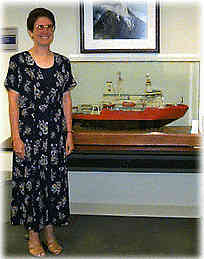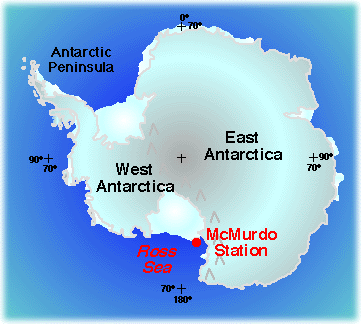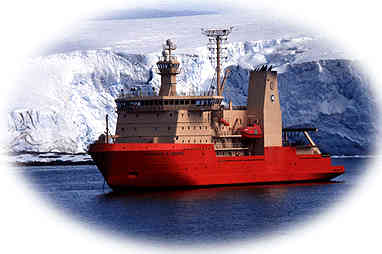
|


Kim
with a model of the R/V Palmer, Suggestions to EducatorsView Kim's Daily Journals with Added Links Hi! My name is Kim Giesting and I am a science teacher at Connersville High School in Connersville, Indiana. Our school includes 1,400 students in grades 9 through 12. We are the only high school in our county of about 25,000 people. I teach Astronomy, Oceanography, Environmental Science, and Earth/Space Science. My husband, Marvin, is also a science teacher at Connersville High School and he teaches Chemistry, A.P. Physics, and Physical Science. We have a shetland sheepdog named Malcolm and enjoy living on three acres of land in southeastern Indiana. Outside of the classroom, I am the assistant speech coach for the Connersville High School speech team. Music is also a very important part of my life. I play the flute and I am the choir director for St. Gabriel Catholic Church. In our spare time, my husband and I like to parcticipate in canoeing, camping, whitewater rafting, and scuba diving. We also like to travel and have visited places such as Belize, Ecuador, and Japan. Every other summer, we take students to Belize, Central America, for a class in tropical ecology. I am really looking forward to my upcoming trip during February and March of 1999 to Antarctica. It will be a dream come true!  Mechanism and Timing of West Antarctic Ice Sheet Retreat at the End of the Last Glacial Maximum John B Anderson, Department of Geology and Geophysics Rice University, Houston, Texas My project involved looking at how big the West Antarctic Ice Sheet was during the last ice age. I was part of a research team working and living aboard the Research Vessel Ice Breaker Nathaniel B. Palmer. The scientists I worked with are especially int erested in the behavior of ice streams, which are rapidly moving "rivers" of ice in an ice sheet. Active ice streams may quickly remove ice from the interior of an ice sheet, causing it to become unstable and contributing to its disintegration. We were investigating how past ice streams behaved with an eye to the present-day the West Antarctic Ice Sheet, which may be unstable and capable of rapid collapse. The research team wants to know just how far glaciers extended across the sea floor during the last ice age (about 20,000 years ago). Ice pushes ocean water aside and becomes "grounded" on the sea floor when it is too thick and heavy to float. As the ic e thinned and retreated back toward the continent, it left features on the sea floor to show that it was once there. We collected evidence of these features by collecting sonar and seismic images, and by examining sediment samples from the floor of the R oss Sea. We needed to work from a ship, because the ocean now occupies the area where the ice was during the last ice age. We used the images we collected to make highly detailed maps of the sea floor from which the maximum extent of the ice can be determined. We looked for "moraines" - large piles of sediment pushed in front of the glacier. The moraine that is farthest fro m the ice today tells us how far the ice used to extend. We also looked for linear features on the sea floor. As the glacier moved across the sea floor, it dragged rocks and debris with it, leaving gouges that help us know in what direction the ice move d. We traced the long troughs carved by fast-flowing ice streams, and we collected sediment cores from the sea floor to see the different layers of debris left by the glaciers. The cores contain material that can be age-dated, helping us to know when th e ice was in a parcticular place. All of these pieces of information put together build a picture of how far the ice extended during the last ice age and how quickly it retreated in the Ross Sea. This information will help us predict how the present Anta rctic ice sheet may change in the future. As I parcticipated in the research, I maintained a daily Internet journal and answered questions from students and teachers across the United States, Belize, and Canada. Visit my journal entries to find out more! Earth's History is Just a Piece of Layer Cake  Kim will work in the Ross Sea......  ....aboard the floating laboratory R/V Palmer! 
March 1999
February 1999
February 1998
January 1998
|
